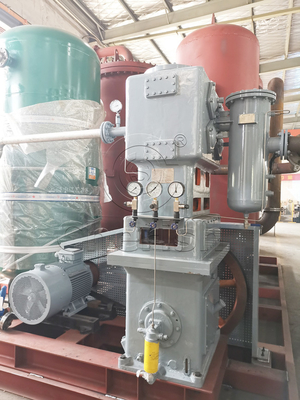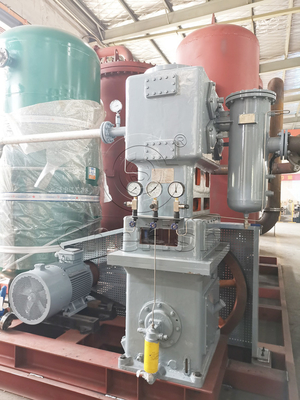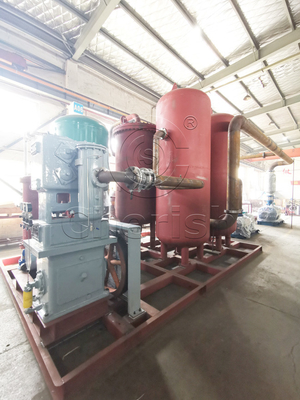Low Energy VPSA Oxygen Generator, Efficient Utilization And Reduced Energy Consumption
| Product name |
VPSA Oxygen Generator |
| Oxygen delivery |
≤300Nm3/hr |
| Purity |
93%±3 |
| Pressure |
0.2~0.3 Mpa |
| Atmospheric dew point |
≤-50℃ |
Working Principle Description:
The working principle of a low-energy consumption VPSA (Vacuum Pressure Swing Adsorption) oxygen generator is based on optimizing various aspects of the process to minimize energy requirements. Here's an overview of its working principle:
Adsorption Stage: Compressed air, after pre-treatment, enters the adsorber unit containing a specialized adsorbent material. The adsorbent selectively adsorbs nitrogen molecules while allowing oxygen molecules to pass through, resulting in the enrichment of oxygen in the adsorbent bed.
Pressure Equalization: Once the adsorption stage is completed, the adsorber enters the pressure equalization phase. During this phase, the pressure in the adsorber is balanced with another adsorber unit that is in the desorption stage. This equalization process allows for efficient gas transfer while minimizing energy losses.
Desorption Stage: In the desorption stage, the pressurized adsorber unit is depressurized to facilitate the release of adsorbed nitrogen. The depressurization can be achieved by reducing the pressure or evacuating the adsorber. By optimizing the pressure reduction process, energy losses can be minimized.
Purge Stage: Following desorption, the adsorber enters the purge stage. During this phase, a portion of the produced oxygen is redirected back into the adsorber to purge any remaining traces of nitrogen. The purge process is optimized to minimize the amount of oxygen required for purging, thus reducing energy consumption.
Cycling and Control: Multiple adsorber units are employed in a cycling operation to ensure continuous oxygen production. The cycling and control system is designed to optimize the timing and coordination of adsorber units, ensuring efficient utilization of resources and minimizing energy wastage.
Heat Recovery: To further reduce energy consumption, heat recovery techniques can be incorporated into the VPSA system. Waste heat generated during the desorption phase can be captured and utilized for various purposes, such as preheating the incoming air or providing process heat, thereby reducing the overall energy requirements.
By optimizing the various stages of the VPSA process, incorporating energy-efficient components and control strategies, and implementing heat recovery techniques, a low-energy consumption VPSA oxygen generator can significantly reduce the energy requirements associated with oxygen production while maintaining reliable and efficient operation.
Product Advantages:
Utilization of adsorption principle: VPSA oxygen generators utilize the adsorption principle for gas separation and purification. By adsorbing gas components onto the adsorbent and then desorbing under reduced pressure, gas separation is achieved. Compared to other oxygen production technologies such as membrane separation or pressure swing adsorption (PSA), VPSA does not require high pressure or high temperature during the separation process, thereby reducing energy consumption.
Recycling of waste gas: VPSA oxygen generators reduce energy consumption by recycling waste gas. During the adsorption process, a portion of the waste gas is collected and reintroduced into the system for recycling. By effectively utilizing the oxygen content in the waste gas, the dependence on external gas sources is reduced, resulting in lower energy consumption.
Optimization of adsorbent selection: VPSA oxygen generators achieve higher adsorption capacity and selectivity through the optimization of adsorbent selection and design. Selecting adsorbents with high adsorption capacity and oxygen selectivity allows for higher oxygen production under the same operating conditions, thereby reducing energy waste.
Efficient and energy-saving equipment design: VPSA oxygen generators prioritize efficient and energy-saving equipment design. By optimizing the structure and fluid dynamics design of the equipment, energy losses and resistance are minimized, thereby improving gas flow efficiency. Additionally, advanced heat exchangers and energy recovery systems are employed to recover and reuse thermal energy, further reducing energy consumption.
Automated control system: VPSA oxygen generators are equipped with advanced automated control systems that monitor and adjust operating parameters in real-time for optimal energy utilization. By precisely controlling the timing and pressure of adsorption and desorption, maximum oxygen production is achieved while minimizing energy waste.
Technical parameters:
● Oxygen delivery: ≤300Nm3/hr;
● Purity: 93%±3
● Pressure: 0.2~0.3 Mpa
● Atmospheric dew point: ≤-50℃
Product picture:


 Your message must be between 20-3,000 characters!
Your message must be between 20-3,000 characters! Please check your E-mail!
Please check your E-mail!  Your message must be between 20-3,000 characters!
Your message must be between 20-3,000 characters! Please check your E-mail!
Please check your E-mail! 




